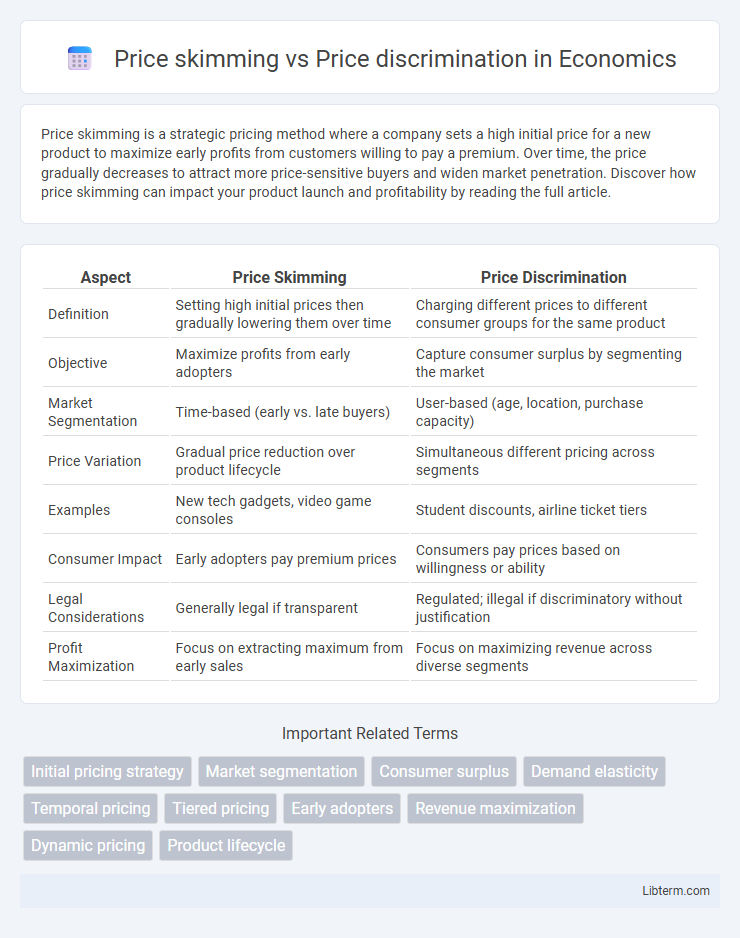Price skimming is a strategic pricing method where a company sets a high initial price for a new product to maximize early profits from customers willing to pay a premium. Over time, the price gradually decreases to attract more price-sensitive buyers and widen market penetration. Discover how price skimming can impact your product launch and profitability by reading the full article.
Table of Comparison
| Aspect | Price Skimming | Price Discrimination |
|---|---|---|
| Definition | Setting high initial prices then gradually lowering them over time | Charging different prices to different consumer groups for the same product |
| Objective | Maximize profits from early adopters | Capture consumer surplus by segmenting the market |
| Market Segmentation | Time-based (early vs. late buyers) | User-based (age, location, purchase capacity) |
| Price Variation | Gradual price reduction over product lifecycle | Simultaneous different pricing across segments |
| Examples | New tech gadgets, video game consoles | Student discounts, airline ticket tiers |
| Consumer Impact | Early adopters pay premium prices | Consumers pay prices based on willingness or ability |
| Legal Considerations | Generally legal if transparent | Regulated; illegal if discriminatory without justification |
| Profit Maximization | Focus on extracting maximum from early sales | Focus on maximizing revenue across diverse segments |
Introduction to Pricing Strategies
Price skimming involves setting high initial prices for a new product to maximize early profits from customers willing to pay more before gradually lowering prices. Price discrimination targets different consumer segments by charging varying prices based on factors such as location, purchase time, or buyer characteristics, optimizing revenue across markets. Both strategies are crucial for businesses aiming to enhance profitability and market penetration through tailored pricing approaches.
Definition of Price Skimming
Price skimming is a pricing strategy where a company sets a high initial price for a new or innovative product to maximize profits from early adopters before gradually lowering the price to attract more price-sensitive customers. This approach helps recover development costs quickly and targets segments willing to pay a premium. In contrast, price discrimination involves charging different prices to different customer groups for the same product based on their willingness to pay or purchase conditions.
Definition of Price Discrimination
Price discrimination refers to the strategy where a business charges different prices to different customers for the same product or service based on factors such as willingness to pay, location, or purchase volume. This approach aims to capture consumer surplus and maximize revenue by segmenting the market according to varying price elasticities. Unlike price skimming, which sets a high initial price to target early adopters before lowering it, price discrimination involves simultaneous pricing structures tailored to diverse customer groups.
Key Differences Between Price Skimming and Price Discrimination
Price skimming involves setting a high initial price for a new or innovative product to maximize profits from early adopters before gradually lowering the price, while price discrimination charges different prices to different consumer groups based on their willingness to pay. Price skimming targets a single product market over time, whereas price discrimination segments the market simultaneously across different groups or conditions. The key difference lies in timing and customer segmentation: price skimming applies temporal pricing strategy, whereas price discrimination employs personalized or group-based pricing strategies.
Advantages of Price Skimming
Price skimming allows companies to maximize revenue by targeting early adopters willing to pay premium prices, leading to higher initial profit margins. This strategy helps quickly recover product development costs and fund future innovations. By capturing value from different customer segments over time, businesses can optimize pricing dynamically and reduce the risk of immediate price wars.
Advantages of Price Discrimination
Price discrimination enables businesses to capture consumer surplus by charging different prices based on willingness to pay, increasing overall revenue and market efficiency. This strategy allows firms to serve diverse customer segments, maximizing profit without reducing access for lower-income consumers. Price discrimination can also lead to better inventory management and enhanced customer satisfaction through tailored pricing.
Disadvantages and Risks of Each Strategy
Price skimming risks include alienating price-sensitive customers and inviting rapid competitive entry when high initial prices signal high margins. Price discrimination challenges involve legal risks and customer backlash due to perceived unfairness, alongside complexities in segmenting markets effectively to prevent arbitrage. Both strategies demand careful market analysis to avoid revenue loss and damage to brand reputation.
Industry Examples: Price Skimming vs Price Discrimination
Price skimming is commonly used in the technology industry, where companies like Apple launch new products at high prices to maximize profits from early adopters before gradually lowering prices. Price discrimination is prevalent in the airline industry, where airlines charge different prices for seats on the same flight based on factors such as booking time, customer segment, and flexibility. These strategies allow businesses to optimize revenue by targeting distinct consumer groups through tailored pricing models.
Factors Influencing Strategy Choice
Price skimming strategy depends heavily on product life cycle stage, market demand elasticity, and competitive intensity, where firms set high initial prices to maximize early profits from less price-sensitive customers. Price discrimination relies on the ability to segment markets based on varying willingness to pay, customer characteristics, and geographic or temporal differences to charge different prices for the same product. Both strategies require firms to consider factors such as customer information availability, legal constraints, and cost structures to optimize pricing decisions effectively.
Conclusion: Choosing the Right Pricing Approach
Choosing between price skimming and price discrimination depends on market conditions and customer segments; price skimming suits new products with inelastic demand, maximizing early profits, while price discrimination targets diverse consumer groups with varying willingness to pay to capture maximum revenue. Businesses must analyze product lifecycle stage, competition, and consumer behavior to optimize pricing strategies. Effective implementation of either approach can significantly enhance profitability and market positioning.
Price skimming Infographic

 libterm.com
libterm.com